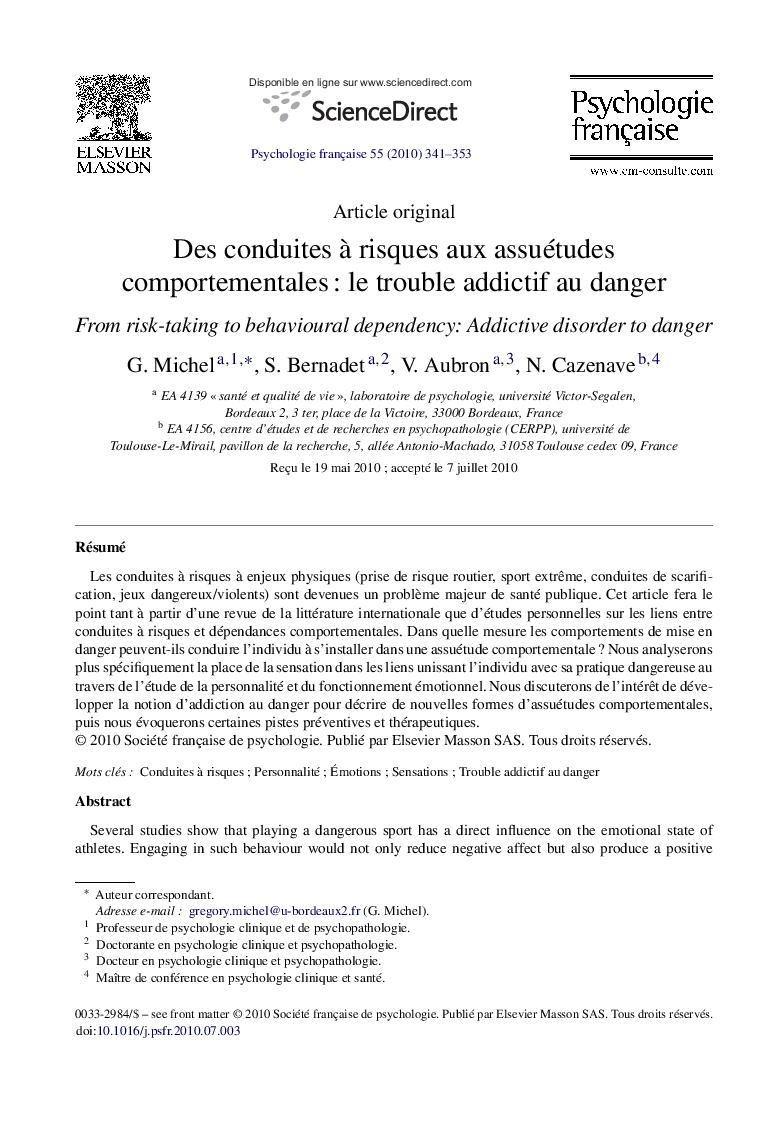| کد مقاله | کد نشریه | سال انتشار | مقاله انگلیسی | نسخه تمام متن |
|---|---|---|---|---|
| 336901 | 547357 | 2010 | 13 صفحه PDF | دانلود رایگان |

RésuméLes conduites à risques à enjeux physiques (prise de risque routier, sport extrême, conduites de scarification, jeux dangereux/violents) sont devenues un problème majeur de santé publique. Cet article fera le point tant à partir d’une revue de la littérature internationale que d’études personnelles sur les liens entre conduites à risques et dépendances comportementales. Dans quelle mesure les comportements de mise en danger peuvent-ils conduire l’individu à s’installer dans une assuétude comportementale ? Nous analyserons plus spécifiquement la place de la sensation dans les liens unissant l’individu avec sa pratique dangereuse au travers de l’étude de la personnalité et du fonctionnement émotionnel. Nous discuterons de l’intérêt de développer la notion d’addiction au danger pour décrire de nouvelles formes d’assuétudes comportementales, puis nous évoquerons certaines pistes préventives et thérapeutiques.
Several studies show that playing a dangerous sport has a direct influence on the emotional state of athletes. Engaging in such behaviour would not only reduce negative affect but also produce a positive affect that does not equate only relief but an “extraordinary experienced”. Notwithstanding the unique qualities of these sports, it is likely that some subclinical individual characteristics such as sensation seeking, emotional–behavioural deregulation can promote a self-reinforcement of these practices or even facilitated the installation of an addictive tendency. Risk and intense sensation are also at the heart of dangerous games. Four points seem to motivate these practices: risk-taking, intensity, loss of consciousness, and the “wake survival”. In addition, practitioners are characterized by a more severe depressive symptomatology than non-practitioners. Some of these depressive elements are probably anterior to the game, but it is also possible that others are the consequence; this has the effect of strengthening the emotional–behavioural addiction. Through these extreme sports and games of non-oxygenation, the level of danger appears to be a real source of excitement. Playing with death is going to give inner magnitude to the experience. Without the sense of risk, the practice of the activity would not make sense. Psychological functioning of these sports and these “players” is based on the need to be stimulated, to be excited by the risk or even the fear in order to be appeased. Also, treat the danger, but also and mainly deal with emotions. The danger as a means of activation may fill in a toxic function of emotional and behavioural self-regulation including a risk that this excitation will self-sustained. Indeed, some of these athletes and these “players” increase their practice and push the safety threshold by adopting behaviours more and more risky in order to experiment higher sensations. When some semiological clues characterize the practice of risky activities like the repetition of a dangerous situation, loss of control, the invasion of the psychic life, time spent at the expense of social, family and school activities… they may reflect a real addiction to danger. It therefore becomes necessary for the clinician and the researcher to identify all these prodromal symptoms and signs of addiction. Criteria for the diagnosis of Addictive Disorder to Danger are proposed and discussed.
Journal: Psychologie Française - Volume 55, Issue 4, December 2010, Pages 341–353